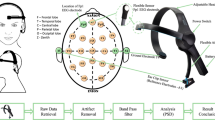Summary
The evoked gamma-band activity is an event related rhythmic response which persists within the first 100ms after the stimulus onset. It shows spectral peaks between 30 and 40 Hz in the auditory, between 45 and 55 Hz in the somatosensory and between 100 and 110 Hz in the visual system. After separation of the wide-band activity in slow and gamma-band activity, a moving single equivalent current dipole model accounts for each activity almost completely. The induced gamma-band activity is not phase-locked to the stimulus or it is strongly gittering and thus it cannot be extracted in time domain. In this case we are using signal analysis methods in frequency domain. The evaluation of the induced brain gamma-band activity around 30 Hz shows differences to word and nonword stimuli. It was supposed that the induced gamma-band activity represents the synchronized activity of Hebbian cell assemblies correlated to words.
Similar content being viewed by others
References
Adrian, E.D. Olfactory reactions in the brain of the hedgehog. Journal of Physiology, 1942, 100: 459–473.
Basar, E. and Bullock, T. Induced rhythms in the brain. Birkhäuser, 1992.
Basar, E. and Özesmi, C. The hyppocampal EEG activity and a systems analytical interpretation of averaged evoked potentials of the brain. Kybernetik, 1972, 12: 45–54.
Basar, E. and Ungan, P. A component analysis and principles derived for the understanding of evoked potentials of the brain: Studies of the hippocampus. Kybernetik, 1973, 12: 133–140.
Basar, E. A study of the time and frequency characteristics of the potentials evoked in the acoustical cortex. Kybernetik, 1972, 10: 61–64.
Basar, E. EEG-Dynamics and evoked potentials in sensory and cognitive processing by the brain. In: Dynamics of Cognitive and Sensory Processing by the Brain. (E. Basar, Ed), Springer-Verlag, Berlin-Heidelberg-New York, 1988: 311–318.
Basar, E., Rosen, B., Basar-Eroglu, C. and Greitschus, F. The associations between 40 Hz-EEG and the middle latency response of the auditory evoked potential. Int J Neuroscience, 1987, 33: 103–117.
Basar-Eroglu, C. and Basar, E. A compound P300-40 Hz response of the cat hippocampus. Int J Neuroscience, 1991, 60: 227–237.
Braitenberg, V. and Pulvermüller, F. Entwurf einer neurologischen Theorie der Sprache. Naturwissenschaften, 1992, 103–117.
Bullock, T.H. and Achimowicz, J.Z. A comparative survey of event related brain oscillations, In: Oscillatory event related brain dynamics. (C. Pantev, T. Elbert and B. Lütkenhöner, Eds), Plenum Press, New York, 1994.
Eckhorn, R., Bauer, R., Jordan, W., Brosch, S., Kruse, W., Munk, M. and Reitboeck, H.J. Coherent oscillations: a mechanism of feature linking in the visual cortex? Biological Cybernetics 1988, 60: 121–130.
Freeman, W.J. Mass action in the nervous system. Academic Press, New York, 1975.
Freeman, W.J. Nonlinear dynamics of paleocortex manifested in the olfactory EEG. Biological Cybernetics, 1979, 35: 21–37.
Galambos, R. and Makeig, S. Dynamic changes in steady-state responses. In: Dynamics of sensory and cognitive processing by the brain. (E. Basar and T. Bullock, Eds), Springer, Berlin, 1988: 103–122.
Galambos, R., Makeig, S. and Talmachoff, P.J. A 40-Hz auditory potential recorded from the human scalp. Proc Natl Acad Sci, 1981, 78: 2643–2647.
Gray, C.M., König, P., Engel, A.K. and Singer, W. Oscillatory response in the cat visual cortex exhibit intercolumnar synchronization which reflects global stimulus properties. Nature, 1989, 338: 334–337.
Hari, R., Hämäläinen, M. and Joutsiniemi, S.L. Neuromagnetic steady-state responses to auditory stimuli. J Acoust Soc Am, 1989, 86: 1033–9.
Kaukoranta, E. and Reinikainen, K. Somatosensory evoked magnetic fields from SI: an interpretation of the spatiotemporal field pattern and effects of stimulus repetition rate. Helskinki University of Technology, Low Temperature Laboratory Report, 1985, TKK-F-A581.
Kuhl, P.K., Williams, K.A., Lacerda, F., Stevens, K.N. and Lindblom, B. Linguistic experience alters phonetic perception in infants by 6 months of age. Science, 1992, 255: 606–608.
Mäkelä, J.P. and Hari, R. Evidence for cortical origin of the 40 Hz auditory evoked response in man. Electroenceph clin Neurophysiol, 1987, 66: 539–46.
Pantev, C., Elbert, T. and Lütkenhöner, B. Oscilatory event related brain dynamics. London, New York: Plenum Press, 1994.
Pantev, C. and Elbert, T. The transient auditory evoked gamma-band field, In: Oscillatory Event Related Brain Dynamics. (C. Pantev, T. Elbert and B. Lütkenhöner, Eds), Plenum Press, London, New York, 1994.
Pantev, C., Bertrand, O., Eulitz, C., Verkindt, C, Hampson, S., Schuirer, G. and Elbert, T. Specific tonotopic organizations of different areas of the human auditory cortex revealed by simultaneous magnetic and electric recordings. Electroenceph clin Neurophysiol, 1994, (in press).
Pantev, C., Elbert, T., Makeig, S., Hampson, S., Eulitz, C. and Hoke, M. Relationship of transient and steady-state auditory evoked fields. Electroenceph clin Neurophysiol, 1993, 88: 389–396.
Pantev, C., Makeig, S., Hoke, M., Galambos, R., Hampson, S. and Gallen, C. Human auditory evoked gamma-band magnetic fields. Proc Natl Acad Sci USA, 1991, 88: 8996–9000.
Ribari, U., Llinas, R., Kluger, A., Suk, J. and Ferris, S.H. Neuropathological dynamics of magnetic, auditory steady-state responses in Alzheimer's disease, In: Advances in Biomagnetism. (S. J. Williamson, M. Hoke, M. Stroink and M. Kotani, Eds), Plenum Press, New York, 1989: 311–314.
Rockstroh, B., Elbert, T., Canavan, A., Lutzenberger, W. and Birbaumer, N. Slow cortical potentials and behaviour. Urban and Schwarzenberg, Baltimore, 1989.
Romani, G.L., Williamson, S.J., Kaufman, L. and Brenner, D. Characterization of the human auditory cortex by the neuromagnetic method. Exp Brain Res, 1982, 47: 381–93.
Rösler, F., Heil, M. and Glowalla, U. Monitoring retrieval from long-term memory by slow event-related potentials. Psychophysiology, 1993, 30: 170–182.
Sannita, W.G. Retinal and cortical oscillatory responses to patterned and unpatterned visual stimulation in man, In: Oscillatory event related brain dynamics. (C. Pantev, T. Elbert and B. Lütkenhöner, Eds), Plenum Press, London, New York, 1994.
Sarvas, J. Basic mathematical and electromagnetic concepts of the biomagnetic inverse problem. Physics in Med Biol, 1987, 32: 11–22.
Author information
Authors and Affiliations
Additional information
This work was supported by a grant from the Deutsche Forschungsgemeinschaft (Klinische Forschergruppe Biomagnetismus und Biosignalanalyse.
Rights and permissions
About this article
Cite this article
Pantev, C. Evoked and induced gamma-band activity of the human cortex. Brain Topogr 7, 321–330 (1995). https://doi.org/10.1007/BF01195258
Accepted:
Issue Date:
DOI: https://doi.org/10.1007/BF01195258




